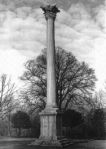
 
 
 
 
|
DiscussionColumnar monument, possibly once crowned by statue of goddess Fortuna Redux, so-called 'Column of the Goths'. Constantinople. Later third to sixth century INSCRIPTION
In three lines:
Fortunae / Reduci ob / devictos Gothos
'To [the goddess] Fortune of Good Return, because of the defeat of the Goths.’
Letter height c. 10 cm.
Another alleged inscription, a Greek NIKA-cross, supposedly on the west side of the pedestal (CIG IV, no. 8926) does not in fact exist (as Peschlow 1991, 220 points out).
The epigraphic formula fits a statue base; the honorand, as usual in Latin in the dative, would then be Fortuna Redux (see below, 'Honorand, Awarder and Date').
DESCRIPTION (from Peschlow 1991 and the published images)
The monument is made up of five parts, all of Proconnesian marble. The overall height is 18.5 m (Peschlow 1991, 217); maximum W and D (at the socle) c. 4.3 m. All parts are only roughly finished with a claw, except for the capital which is smoothly finished.
(1) At the very bottom of the monument is a socle of three steps, made up of large blocks 20-30 cm high.
(2) The pedestal, with mouldings at top and bottom, is set on the top step of the socle, slightly off-centre: H c.330, W c.240 cm. The inscription is on its eastern side and carved over an earlier erased inscription laid out in eight lines (possibly an epigram, Peschlow 1991, 222-3). This first use of the pedestal cannot be dated.
(3) The column-base is of the late-antique 'unfinished’ type (Peschlow 1991, 224-6), made up of a square plinth, a lower cylindrical element (torus), a conical element, and an upper cylindrical element (torus).
(4) The shaft has neck-rings at top and bottom.
(5) On top of the shaft there is a Corinthian capital, projecting slightly over the neck-ring of the shaft. This is the only finished part of the monument. As Peschlow 1991, 226-7 points out, it is a re-used Corinthian standard capital of the Severan period (late 2nd/ early 3rd century).
PROVENANCE AND CURRENT LOCATION
The column is standing in situ in the Gülhane Parkı in Istanbul, on the northeastern slope of the Acropolis of ancient Byzantium, north of the Topkapı Serail. Although this was certainly the Acropolis of Byzantium, the precise ancient topography of the area remains unknown (Mango 1990, 18-19, 33-4; Peschlow 1991, 220).
HONORAND AND DATE
There is no hard archaeological evidence to show whether the capital was crowned by a statue, and no late-antique or Byzantine literary reference can be securely related to this monument. It therefore remains uncertain whether there was ever a statue, and, if so, to whom. Müller-Wiener 1977, 53 identified the column with a monument mentioned by Nicephoros Gregoras in the early 14th century, which is said to have carried a statue of the mythical founder-hero of Byzantium, Byzas (Niceph. Greg. I 305 B). Mango 1993, 1-2, connected it to a note by John Lydus, about a column crowned by a statue of Tyche, the Greek goddess of Fortune. This note could well refer to a statue of Fortuna Redux, the honorand of our inscription (see above, 'Inscription').
The mention in the inscription of a victory over Goths has led scholars to connect the monument with a variety of historical events, from the successful resistance of Byzantium against a Gothic siege in 268, to the victory of Narses over Totila in 552 (for the various attributions and a critical account on them see Peschlow 1991, 218-19). Modern scholars have tended to favour a Constantinian date (Janin 1964, 85-6; Deichmann 1971, 512; Müller-Wiener 1977, 53; Mango 2000, 177). However, Peschlow 1991 proposed a Theodosian date (re-using a Severan capital and a Constantinian pedestal), while Jordan-Ruwe 1995, 175-6, 200 made the case for a Justinianic date, because of its poor finish, and its position at the eastern end of the city. In our opinion, a column dedicated to the goddess Fortuna (and possibly crowned by her statue) is unlikely to date from deep into Christian times.
Ulrich Gehn
Main Reference
Corpus Inscriptionum Latinarum; , III, 733
Łajtar, A., Die Inschriften von Byzantion. Teil I. Die Inschriften, Bonn 2000, pp. 44-6 no. 15
Peschlow, U., Betrachtungen zur Gotensäule in Istanbul, Festschrift für Josef Engemann (Jahrbuch für Antike und Christentum, Ergänzungsband 18), pp. 215-28, Münster 1991,
Discussion References
Deichmann, F. W., Review of Kramer, Byzantinische Zeitschrift 64, p. 512-13, München 1971,
Janin, R., Constantinople byzantine : développement urbain et répertoire topographique, Paris 1964,
Jordan-Ruwe, M., Das Säulenmonument. Zur Geschichte der erhöhten Aufstellung antiker Porträtstatuen (Asia Minor Studien Band 19), Bonn 1995,
Mango, C., Le Développement urbain de Constantinople (IVe-VIIe siècles) (Travaux et Memoires du Centre de Recherche d’Histoire et Civilisation de Byzance, Collège de France, Monographies 2), Paris 1990,
Mango, C., The columns of Justinian and his successors, C. Mango, Studies on Constantinople, ch. X, Aldershot 1993,
Mango, C., The Triumphal Way of Constantinople and the Golden Gate, Dumbarton Oaks Papers 54, 2000, 173-88,
Müller-Wiener, W., Bildlexikon zur Topographie Istanbuls, Tübingen 1977,
|

